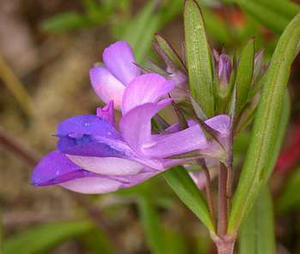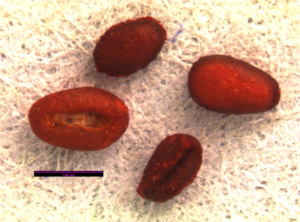Difference between revisions of "Collinsia grandiflora"
(→Taxonomy) |
|||
| Line 1: | Line 1: | ||
| − | * | + | * Scientific Name: ''Collinsia'' ''grandiflora'' |
* Family: Plantaginaceae | * Family: Plantaginaceae | ||
* Common Names: large-flowered blue-eyed Mary, blue-lips blue-eyed Mary | * Common Names: large-flowered blue-eyed Mary, blue-lips blue-eyed Mary | ||
* Synonyms/Misapplications: ''Collinsia'' ''parviflora'' | * Synonyms/Misapplications: ''Collinsia'' ''parviflora'' | ||
* Codon: COLGRA | * Codon: COLGRA | ||
| − | + | [[File: Cogr.png |thumb|Photo by Ben Legler, 2004. Featured on Main Page]] | |
| − | == Taxonomy == | + | === Taxonomy === |
{{Taxobox | {{Taxobox | ||
| − | | name = | + | | name = |
| + | | image = | ||
| image_alt = ''Collinsia grandiflora'' | | image_alt = ''Collinsia grandiflora'' | ||
| image_caption = Photo by Ben Legler, 2004. Featured on Main Page | | image_caption = Photo by Ben Legler, 2004. Featured on Main Page | ||
| Line 29: | Line 30: | ||
<ref>Integrated Taxonomic Information System. Retrieved from https://www.itis.gov/servlet/SingleRpt/SingleRpt?search_topic=TSN&search_value=33530</ref> | <ref>Integrated Taxonomic Information System. Retrieved from https://www.itis.gov/servlet/SingleRpt/SingleRpt?search_topic=TSN&search_value=33530</ref> | ||
| − | ==Description== | + | ===Description=== |
Collinsia grandiflora, Scrophulariaceae , Large-flowered blue-eyed Mary, Blue-lips blue-eyed Mary, Giant blue-eyed Mary | Collinsia grandiflora, Scrophulariaceae , Large-flowered blue-eyed Mary, Blue-lips blue-eyed Mary, Giant blue-eyed Mary | ||
General: Annual, the stem simple or branched, erect, 0.5-5 dm. tall, minutely pubescent. | General: Annual, the stem simple or branched, erect, 0.5-5 dm. tall, minutely pubescent. | ||
| Line 39: | Line 40: | ||
Fruit: Capsule opening along 4 lines. | Fruit: Capsule opening along 4 lines. | ||
| − | ==Bloom Period== | + | ===Bloom Period=== |
April - June | April - June | ||
| − | ==Distribution== | + | ===Distribution=== |
West of the Cascade summits, British Columbia to California, and in the Columbia River Gorge. | West of the Cascade summits, British Columbia to California, and in the Columbia River Gorge. | ||
| − | ==Habitat== | + | ===Habitat=== |
Ecological Setting-Open, moist to rather dry areas, low to moderate elevations in the mountains. | Ecological Setting-Open, moist to rather dry areas, low to moderate elevations in the mountains. | ||
Soil Texture-Fine to medium | Soil Texture-Fine to medium | ||
| Line 52: | Line 53: | ||
Shade Tolerance-Part shade | Shade Tolerance-Part shade | ||
| − | ==Uses== | + | ===Uses=== |
| − | ==Propagation== | + | ===Propagation=== |
Sow seeds in both the fall and early spring for the maximum season of flowering. | Sow seeds in both the fall and early spring for the maximum season of flowering. | ||
| Line 89: | Line 90: | ||
{{Basics}} | {{Basics}} | ||
| − | |||
| − | ==Photo Gallery== | + | ===Photo Gallery=== |
<gallery> | <gallery> | ||
File:CLAM CNLMvol flw 7-2008.JPG|Photo by Rod Gilbert | File:CLAM CNLMvol flw 7-2008.JPG|Photo by Rod Gilbert | ||
| Line 97: | Line 97: | ||
File:COLGRA2.jpg|Seedling, courtesy CNLM | File:COLGRA2.jpg|Seedling, courtesy CNLM | ||
</gallery> | </gallery> | ||
| + | |||
| + | ===References=== | ||
Revision as of 14:12, 20 March 2021
- Scientific Name: Collinsia grandiflora
- Family: Plantaginaceae
- Common Names: large-flowered blue-eyed Mary, blue-lips blue-eyed Mary
- Synonyms/Misapplications: Collinsia parviflora
- Codon: COLGRA
Contents
Taxonomy
| Scientific classification | |
|---|---|
| Kingdom: | Plantae |
| Subkingdom: | Viridiplantae |
| Phylum: | Tracheophyta |
| Subphylum: | Spermatophytina |
| Class: | Magnoliopsida |
| Subclass: | Asteranae |
| Order: | Lamiales |
| Family: | Plantaginaceae |
| Genus: | Collinsia Nutt. |
| Species: | Collinsia grandiflora Douglas ex Lindl. |
| Synonyms | |
| |
Description
Collinsia grandiflora, Scrophulariaceae , Large-flowered blue-eyed Mary, Blue-lips blue-eyed Mary, Giant blue-eyed Mary General: Annual, the stem simple or branched, erect, 0.5-5 dm. tall, minutely pubescent.
Leaves: Lower leaves opposite, petiolate, often toothed when well developed; upper leaves opposite or whorled, entire, usually glabrous, becoming sessile upward, narrowly elliptic or oblong to nearly linear.
Flowers: Flowers 1-few on short pedicels in the axils of reduced upper leaves; calyx 5-8 mm. long, 5-lobed; corolla bi-labiate, blue with white or pinkish upper lip, 9-17 mm. long, the tube abruptly bent at a right angle to the calyx, shortly pouched at the bend; stamens 4.
Fruit: Capsule opening along 4 lines.
Bloom Period
April - June
Distribution
West of the Cascade summits, British Columbia to California, and in the Columbia River Gorge.
Habitat
Ecological Setting-Open, moist to rather dry areas, low to moderate elevations in the mountains. Soil Texture-Fine to medium Nutrients-Medium nutrient requirements Soil Reaction / Salinity-No salinity tolerance Moisture Regime-Moist to drier soil not heat resistant and requires cool nights. Shade Tolerance-Part shade
Uses
Propagation
Sow seeds in both the fall and early spring for the maximum season of flowering.
| FloweringTime | April - June |
| Crop Intervals | Annual |
Seed
Seed sample from: 2010
'Average measurement: 0.7 x 1.5 x 1
Measurement range: L: 0.5 - 0.9, W: 1 -1.6, D: 0.7 – 1.1
Features
Color: Seed bright red with a large, white, elliptical shaped depression on the longer face of the seed that is the hilium.
Syrface: Seeds matte and bumpy, with some wrinkling around the hilium depression.
Could be confused with: Collinsia parviflora.
Latitudinal cross section: elliptical ![]()
Longitudinal cross section: irregular
Basic Explanations and Assumptions:
The dimensions for the seeds are length x width x depth. The location of the hilum is used as the base of the seed, and the length is measured from hilum to the opposite apex. Where a style is present, the length is measured from the hilum to the bottom of the style. Width is measured at a right angle to the length at the widest part. Depth is measured at a right angle to the intersection of height and width lines.
Measurements included are the mean average for each measurement of ten separate seeds.
All measurements in millimeters unless otherwise noted.
Photo Gallery
References
- ↑ Integrated Taxonomic Information System. Retrieved from https://www.itis.gov/servlet/SingleRpt/SingleRpt?search_topic=TSN&search_value=33530





